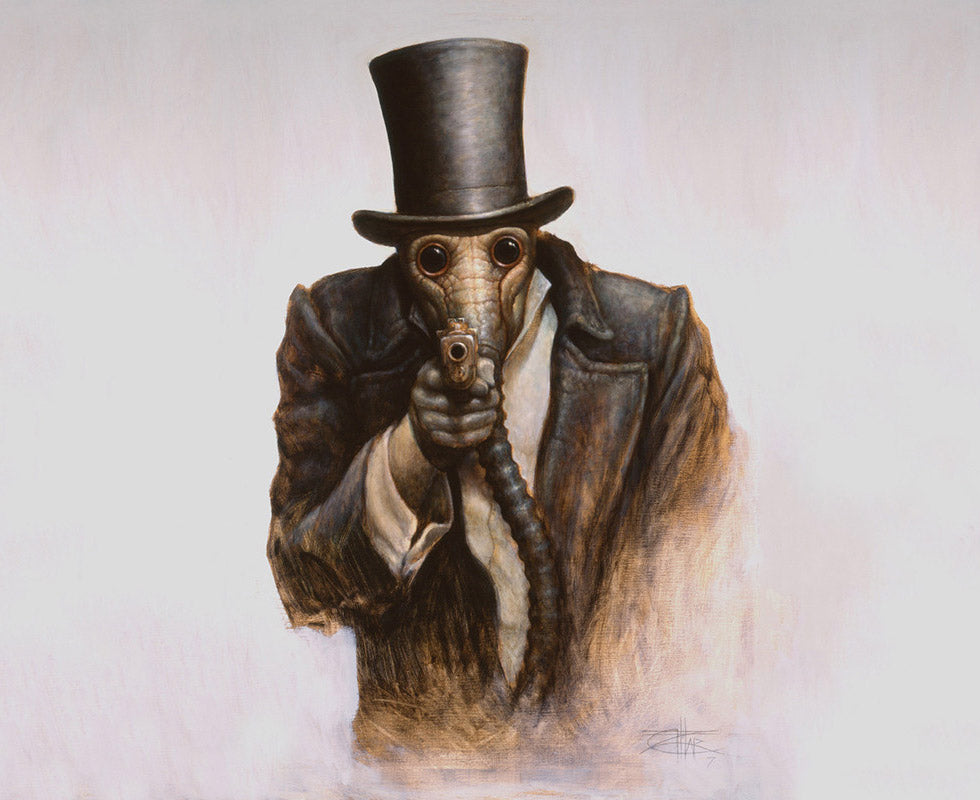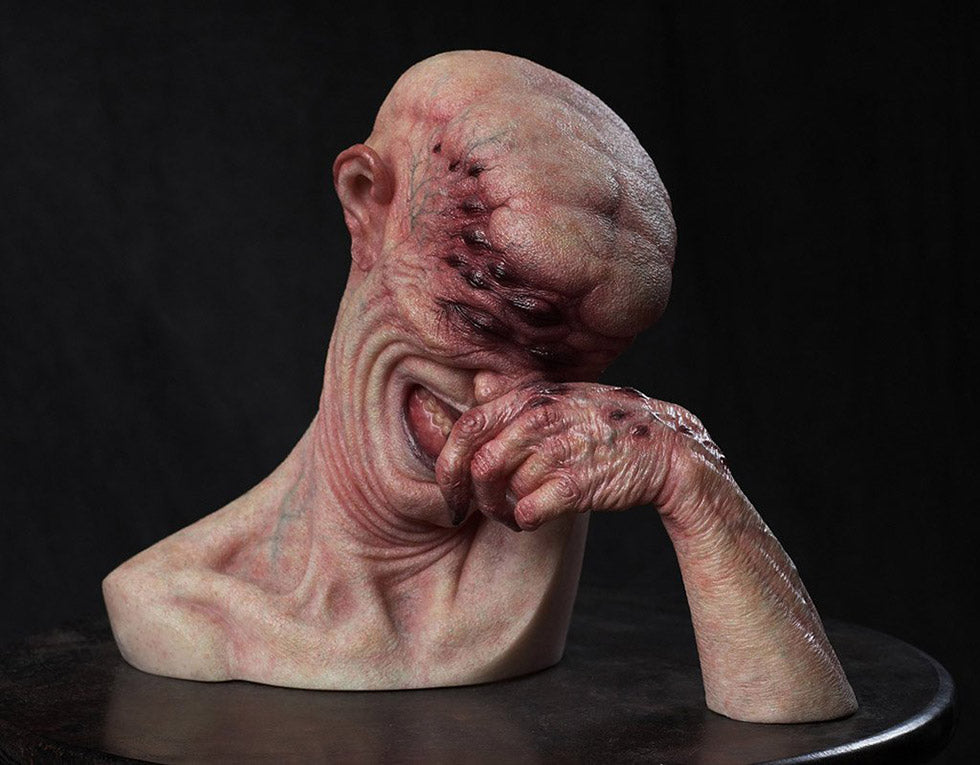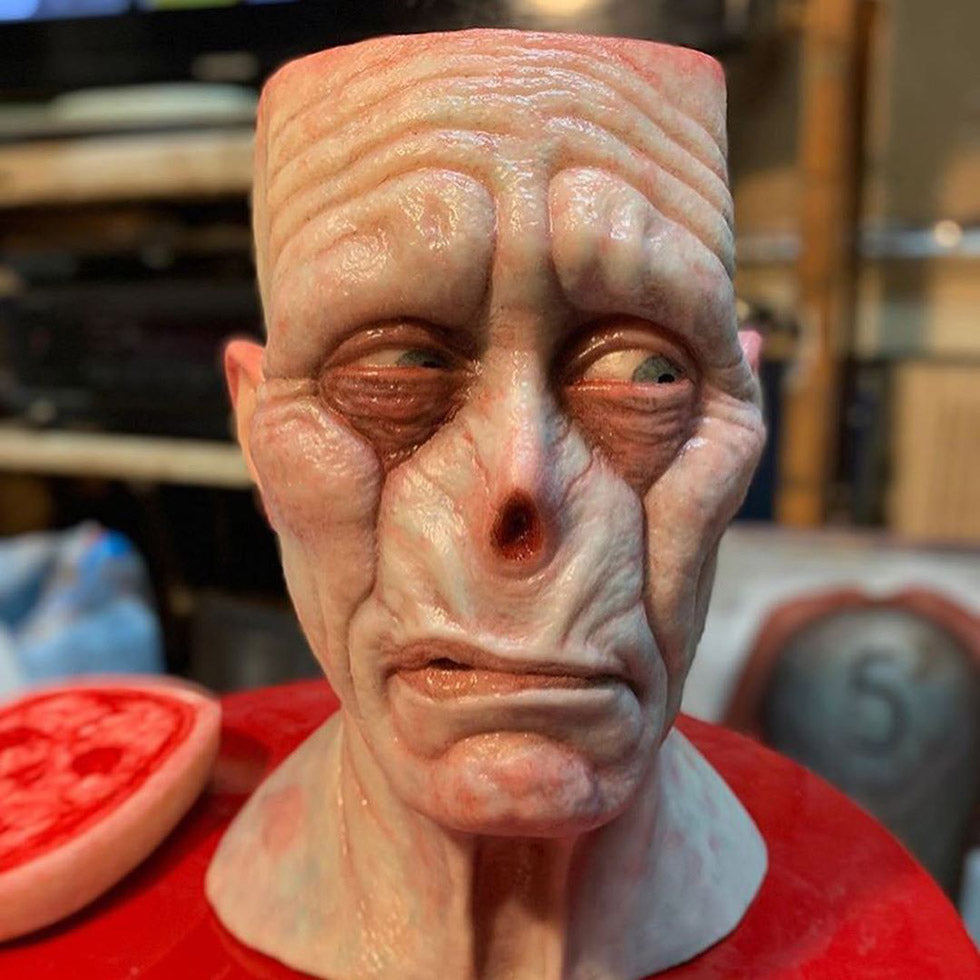For those interested in dark art and horror, the art and creativity of Chet Zar has no doubt entered their minds. A multi-disciplined artist, Zar’s work spans decades and has stayed true to the original inspirations that prompted him to make art. After spending many years working in Hollywood as a special effects artist on such notable movies as Darkman, Hellboy, Planet of the Apes, and multiple Tool videos, Zar decided to take his skills in the direction of fine art, and since then established himself as a master in contemporary art and a growing movement of dark artists around the world. He has curated multiple group shows, and is the founder of the Dark Art Society and host of a long running podcast that focuses on a scene he as inspired in so many ways.
I think Dark Art is a safe way to confront our own shadow side (which we all have) and make peace with it. Or at the very least, to understand it. —Chet Zar
See available paintings by Chet Zar.

Shamanic Tendencies - Oil on canvas.
Josh G: You've been interested in monsters and dark art since you were a kid. How has your view on dark art changed over the years, if it all, due to simply growing older and becoming more aware of the world around us?
Chet Zar: If anything, I think it’s become more relevant. I still have a great love and attraction to it but I guess I am a little more discerning than I used to be. With its increasing popularity there are a lot of people who don’t quite get it and go straight for the upside down crosses and pentagrams. That is such a limited interpretation of what Dark Art really is. I’m hoping as a community of artists we can move past that stuff and really dig deep within ourselves and confront our own darkness. This is where the power lies, not in the regurgitation of Hollywood horror movies misunderstandings of the occult and pop culture symbology.

Ego Death - Oil on canvas.
JG: For years you worked in the movie industry doing special and makeup fx. How do you think this experience helped you when you made the change to focus more on your personal art?
CZ: It made me realise that no matter how high up the chain you get in FX, you are still ultimately just a pair of hands serving another person’s vision. Now there is nothing inherently wrong with this. In fact, I believe serving others is our highest calling. But who are you serving? It’s a rare occasion when you get to work for a real visionary who is worthy of your talents. I have often said that if the film industry was full of people like Guillermo del Toro, I may not have left it. There are not enough Sam Rami’s, Martin Scorcese’s, etc but there are a shitload of Michael Bay’s.
So I guess the experience of the endless let downs working for people that I felt were less talented than the FX crew itself just made me wise up to the fact that if I wanted to do things that I thought were worthwhile, I was going to have to do them myself.
It was a great artistic education for me and I will be forever grateful for that. I also made some great friends and got to work with some really talented people. But sometimes I wish I had the foresight to have started straight in with my own personal work instead, although I don’t think I would be as good of an artist, technically speaking. I really learned a lot there and it helped form me into the artist I am now.

Crooked Smile and Skull Administrator from Chet Zar's show, The Administrators.
JG: As with most movements, dark art tends to have a lot of misconceptions and stereotypes placed on it. Can you talk a bit about what a person viewing your art, or dark art for the first time would not expect learning?
CZ: Dark doesn’t necessarily mean “evil”. I think that is the biggest misconception. Dark can mean a lot of things and “evil” is only a tiny fraction of it. Dark is the mystery, the hidden places of our psyche, our subconscious. And that’s where all the juicy stuff is! I think Dark Art is a safe way to confront our own shadow side (which we all have) and make peace with it. Or at the very least, to understand it.

I Want You - Oil on canvas.
JG: Along with creating art, you've also been curating art shows such as Conjoined and the Dark Art Society group show. What got you interested in curating and what do you like and dislike about it?
CZ: Having a strong relationship with Copro gallery gave me the opportunity to try it out. They were very cool to let me curate, especially since the first couple I did were total bombs. But they stuck with me and it’s been very fruitful.
I really enjoy choosing the artists that I like and think deserve more exposure. That’s really personally rewarding. I dislike the organisational aspect of it, like contacting all the artists and keeping them updated with emails and stuff. I’m not a very organised person. I wish I was but I’m not wired that way. But I’m always working on it!

Heartbroken - Urethane Sculpture and oil paint by Chet Zar.
JG: How do you feel your work has evolved over the years, and with this in mind, what are some of the most significant series you have created? Also, how do these series relate to your book Dy5topia?
CZ: Probably the biggest evolution is that I figured out what the hell I was doing! I didn’t go to art school and I was mostly self taught so I used to really just feel my way through a painting until it looked right. Once I started teaching seminars at tattoo conventions and stuff I had to really figure out what I was doing. So a lot of my focus over the past 10 years or so has been trying to understand my own process, refining it and verbalising it in order to be able to teach it.
But during this whole period I was just doing what I usually do when it comes to painting- just following my nose….or following my art, I guess you could say. I never set out with a plan to create a world full of characters but with the Dy5topia project, I have done exactly that. Dy5topia is basically going to be a field guide to the world I have been painting for the last 15-20 years. I’m treating it like it’s a real place, kind of a hell realm or other dimension. I suppose that Dy5topia is really my biggest evolution as an artist, but it was kind of after the fact. I looked back on all these paintings and thought (with other people telling me this as well), “Hey! These creatures look related and they look like they all exist in the same kind of world!”. And Dy5topia was born. It’s a book project that I Kickstarted and it’s about 3 years late at this point. But I’m so close to finishing it!!!!!

Faceless Administrator & Spider Administrator from Chet Zar's show, The Administrators.
JG: How do you think your childhood and experiences lead you to making dark art?
CZ: Well, my grandfather used to turn the lights off in his house and chase us around with a caveman mask on...that might have had something to do with it haha. There was also a lot of family strife, arguments, parents divorcing, etc that I think kind of drove me to horror movies. Well, not drove me there but gave me something I could relate to, something I could place those feelings of fear and anxiety that I had from the trauma. I think there was a kind of recognition there. When I saw a horror movie on TV I think in the back of my mind I was like “Hmmm...I am familiar with this feeling this movie is giving me.”. Of course this is a kind of “after the fact” self analysis of me trying to make sense of it. The other possible (and probable) reason is just that I’m built this way. I always loved the weird, the spooky, the bizarre. It feels like it’s in my blood.

Softspot - Urethane Sculpture and oil paint by Chet Zar.
JG: What are some of your future plans for you work, and goals for the dark art movement?
CZ: First: finish the Dy5topia project. Once the book is finished I would like to start thinking about making a Dy5topia film...or maybe a comic book first. I’m still not sure. I would like to continue to explore that world and use new mediums to do that. Film would be the ultimate, though. I used to be really into making movies on my dads super 8 camera when I was a little kid. I wanted to be a director before I got into makeup effects. I’m a huge fan of film. I think I could do it.

The Dance - Oil on canvas.
JG: In the past couple years you started the Dark Art Society and have hosted the Dark Art Society podcast. Can you talk a bit about how both of those started and what you see for them in the future?
CZ: It all started while Mike Correll was making a documentary about me (Chet Zar: I Like To Paint Monsters). We would have these long conversations about where the documentary was going and how it was organically forming based on footage shot, the art shows that happened while filming, etc.
One thing we both noticed was how many fans of Dark Art were at these shows and events we were filming at and how big the movement was getting at a grassroots level. It was clear that this documentary wanted to be about more than just me. It wanted to be about the Dark Art movement as a whole as well.
We both kind of had the same epiphany at around the same time: this thing was bigger than either of us. So we decided to take up the mantle and try and form some sort of community. Other than the documentary, the podcast seemed like a logical place to start. It started out as an extension of these phone calls he and I would have about the movement and whatever else we found interesting. Mike was gracious enough to manage the technical stuff like promotion, posting, etc. I wouldn’t have started it without him because my time is so limited. It started as he and i just talking about this stuff with artist interviews here and there. But eventually he had to leave the show to pursue other life stuff and I had to figure out how to keep it going. With no co host to rely on, I decided to go with artist interviews and it was really the shot in the arm that the podcast needed. Hearing different artists stories is fascinating and the DAS podcast covers a lot of artists that other art podcasts don’t. While it’s not exclusively dark artists who are interviewed, it is mostly dark artists, because I feel like we tend to get pushed to the margins. So this podcast is a place where they are taken seriously. The original idea with the Dark Art Society was to educate the general public about Dark Art. What better way than to interview the artists themselves?

Black Magick in the Valley of Death - Oil on canvas.
JG: Are there any artists from the past that you would have liked to interview?
CZ: Beksiński! Giger! There are too many to name but those are the two big ones that come to mind.
JG: Your work has inspired a wide variety of artists, and can often be seen in the style and techniques used. What artists inspired your work the most?
CZ: There are a lot...a LOT...that have inspired me over the years but the big three for me are Frazetta, Beksinski and Giger. They came into my consciousness at crucial points in my life so I will always have a soft spot for them.

Worried Creep - Urethane Sculpture and oil paint.
JG: Aside from painting styles or techniques, what artists do you admire based on imagination alone?
CZ: I’m on a big Dos Diablos kick lately. I love the freedom to get weird that he has. I’m also really digging Vanessa Lemen. I think it’s artists who are looser and freer than I tend to be. I admire that and want to go there more in my own work.
JG: Last one, when future generations look back on this dark art movement, at this current time, what one thing do you hope they learn from it?
CZ: Don’t be afraid of the dark.

The Hungry Ghost of Blood Castle - Oil on canvas.
To see more of Chet’s work, be sure to check out his website, support him on Patreon and follow him on Instagram. You can learn more about the Dark Art Society and how you can contribute, and listen to the latest episode of the Dark Art Society Podcast. See Chet's latest solo show at the Beinart Gallery, The Administrators.
This interview was written by Josh G from Creep Machine for the Beinart Gallery in November 2019.
Josh G works in social media and marketing during the day, and in his free time is an art historian with a focus on lowbrow, pop surrealism, and dark art. He started the Creep Machine art site in 2007, has curated a handful of shows, and is dedicated to empowering artists with technology.




 Cart
Cart




